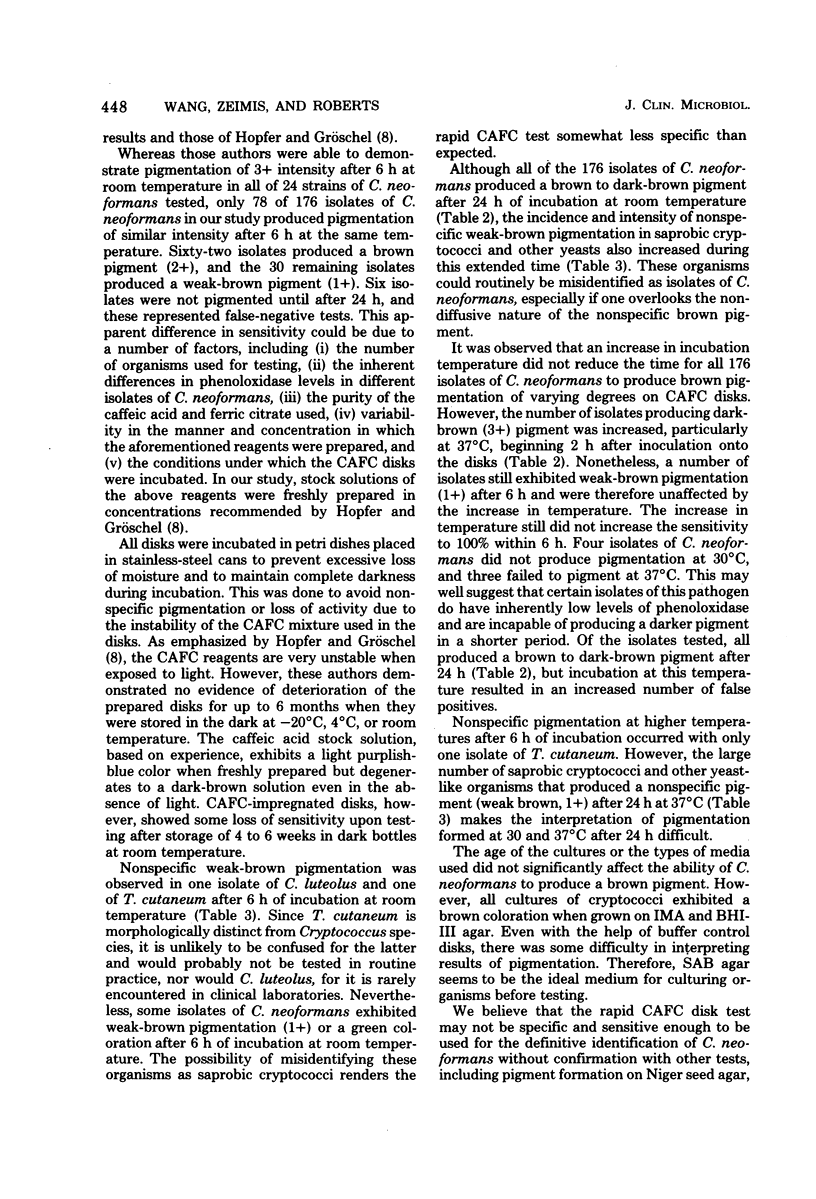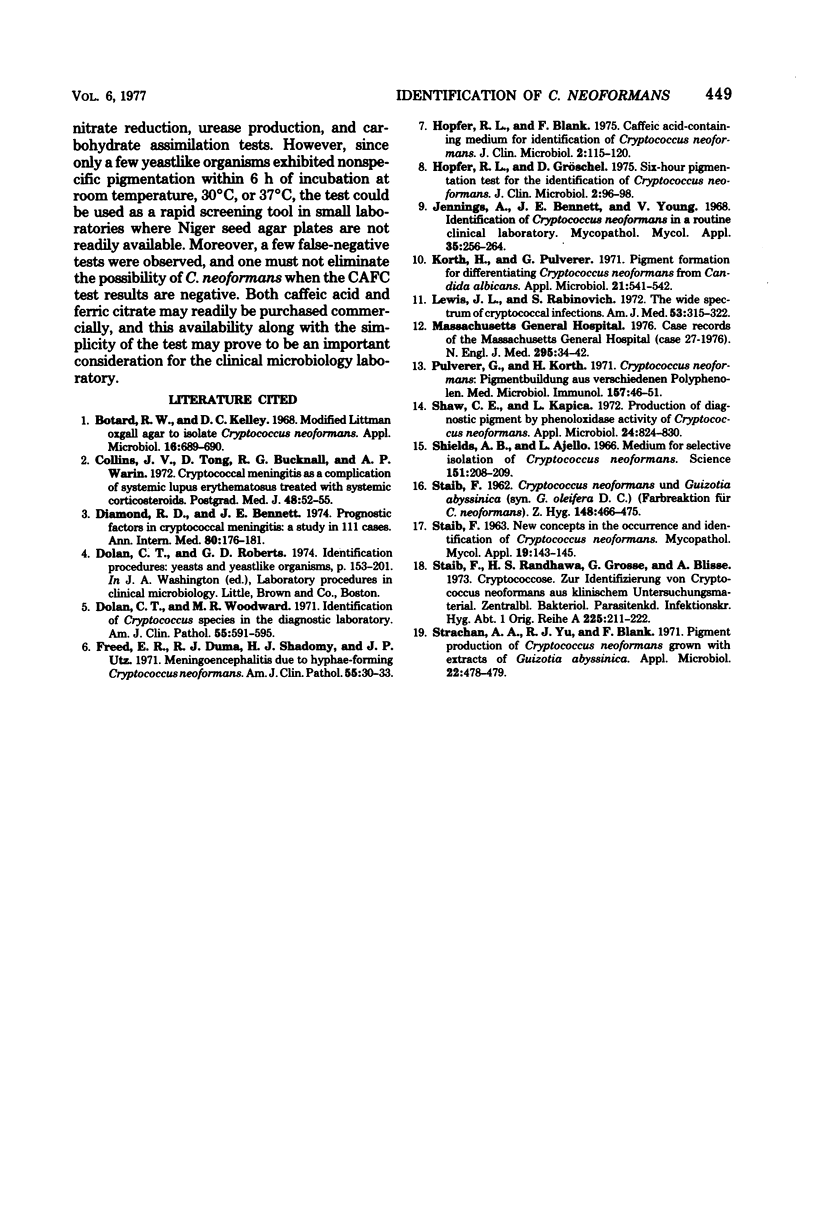Abstract
An evaluation of a rapid caffeic acid-ferric citrate paper disk test for the identification of Cryptococcus neoformans, using 474 isolates of yeasts and yeastlike organisms, showed that 96.6, 97.7, and 98.3% of 176 isolates of C. neoformans produced brown to dark-brown pigment on disks incubated for 6 h at room temperature, 30 degrees C, and 37 degrees C, respectively. All C. neoformans produced brown to dark-brown pigment within 24 h. However, nonspecific pigmentation was encountered at all temperatures of incubation with one isolate of Trichosporon cutaneum and, at room temperature only, with one isolate of C. luteolus after 6 h. Other genera of yeasts produced similar pigmentation after 24 h at all temperatures. The age of the cultures tested or the types of media used before testing did not significantly affect the ability of C. neoformans to produce pigmentation at 37 degrees C. A positive test may prove useful for presumptive identification of C. neoformans, but a negative reaction should not be used to rule out an identification of this yeast. Since a number of false-negative and false-positive tests occur, it is necessary to confirm, by other biochemical tests, the identification of all organisms suspected of being C. neoformans, to reduct the serious risk of missing or misidentifying this important pathogen.
Full text
PDF




Selected References
These references are in PubMed. This may not be the complete list of references from this article.
- Botard R. W., Kelley D. C. Modified Littman oxgall agar to isolate Cryptococcus neoformans. Appl Microbiol. 1968 May;16(5):689–690. doi: 10.1128/am.16.5.689-690.1968. [DOI] [PMC free article] [PubMed] [Google Scholar]
- Collins J. V., Tong D., Bucknall R. G., Warin A. P. Cryptococcal meningitis as a complication of systemic lupus erythematosus treated with systemic corticosteroids. Postgrad Med J. 1972 Jan;48(555):52–55. doi: 10.1136/pgmj.48.555.52. [DOI] [PMC free article] [PubMed] [Google Scholar]
- Diamond R. D., Bennett J. E. Prognostic factors in cryptococcal meningitis. A study in 111 cases. Ann Intern Med. 1974 Feb;80(2):176–181. doi: 10.7326/0003-4819-80-2-176. [DOI] [PubMed] [Google Scholar]
- Dolan C. T., Woodward M. R. Identification of Cryptococcus species in the diagnostic laboratory. Am J Clin Pathol. 1971 May;55(5):591–595. doi: 10.1093/ajcp/55.5.591. [DOI] [PubMed] [Google Scholar]
- Freed E. R., Duma R. J., Shadomy H. J., Utz J. P. Meningoencephalitis due to hyphae-forming Cryptococcus neoformans. Am J Clin Pathol. 1971 Jan;55(1):30–33. doi: 10.1093/ajcp/55.1.30. [DOI] [PubMed] [Google Scholar]
- Hopfer R. L., Blank F. Caffeic acid-containing medium for identification of Cryptococcus neoformans. J Clin Microbiol. 1976 Aug;2(2):115–120. [PMC free article] [PubMed] [Google Scholar]
- Hopfer R. L., Gröschel D. Six-hour pigmentation test for the identification of Cryptococcus neoformans. J Clin Microbiol. 1976 Aug;2(2):96–98. [PMC free article] [PubMed] [Google Scholar]
- Jennings A., Bennett J. E., Young V. Identification of Cryptococcus neoformans in a routine clinical laboratory. Mycopathol Mycol Appl. 1968 Oct 14;35(3):256–264. doi: 10.1007/BF02050740. [DOI] [PubMed] [Google Scholar]
- Korth H., Pulverer G. Pigment formation for differentiating Cryptococcus neoformans from Candida albicans. Appl Microbiol. 1971 Mar;21(3):541–542. doi: 10.1128/am.21.3.541-542.1971. [DOI] [PMC free article] [PubMed] [Google Scholar]
- Lewis J. L., Rabinovich S. The wide spectrum of cryptococcal infections. Am J Med. 1972 Sep;53(3):315–322. doi: 10.1016/0002-9343(72)90174-x. [DOI] [PubMed] [Google Scholar]
- Pulverer G., Korth H. Cryptococcus neoformans: pigmentbildung aus verschiedenen Polyphenolen. Med Microbiol Immunol. 1971;157(1):46–51. doi: 10.1007/BF02121290. [DOI] [PubMed] [Google Scholar]
- Shaw C. E., Kapica L. Production of diagnostic pigment by phenoloxidase activity of cryptococcus neoformans. Appl Microbiol. 1972 Nov;24(5):824–830. doi: 10.1128/am.24.5.824-830.1972. [DOI] [PMC free article] [PubMed] [Google Scholar]
- Shields A. B., Ajello L. Medium for selective isolation of Cryptococcus neoformans. Science. 1966 Jan 14;151(3707):208–209. doi: 10.1126/science.151.3707.208. [DOI] [PubMed] [Google Scholar]
- Staib F., Randhawa H. S., Grosse G., Blisse A. Cryptococcose. Zur Identifizierung von Cryptococcus neoformans aus klinischem Untersuchungsmaterial. Zentralbl Bakteriol Orig A. 1973 Dec;225(2):211–222. [PubMed] [Google Scholar]
- Strachan A. A., Yu R. J., Blank F. Pigment production of Cryptococcus neoformans grown with extracts of Guizotia abyssinica. Appl Microbiol. 1971 Sep;22(3):478–479. doi: 10.1128/am.22.3.478-479.1971. [DOI] [PMC free article] [PubMed] [Google Scholar]


